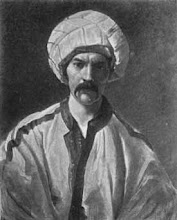Of all the lands there are for dismal scenery, I think Palestine must be
the prince. The hills are barren, they are dull of color, they are
unpicturesque in shape. The valleys are unsightly deserts fringed with a
feeble vegetation that has an expression about it of being sorrowful and
despondent. The Dead Sea and the Sea of Galilee sleep in the midst of a
vast stretch of hill and plain wherein the eye rests upon no pleasant
tint, no striking object, no soft picture dreaming in a purple haze or
mottled with the shadows of the clouds. Every outline is harsh, every
feature is distinct, there is no perspective—distance works no
enchantment here. It is a hopeless, dreary, heart-broken land.
Small shreds and patches of it must be very beautiful in the full flush of
spring, however, and all the more beautiful by contrast with the
far-reaching desolation that surrounds them on every side. I would like
much to see the fringes of the Jordan in spring-time, and Shechem,
Esdraelon, Ajalon and the borders of Galilee—but even then these
spots would seem mere toy gardens set at wide intervals in the waste of a
limitless desolation.
Palestine sits in sackcloth and ashes. Over it broods the spell of a curse
that has withered its fields and fettered its energies. Where Sodom and
Gomorrah reared their domes and towers, that solemn sea now floods the
plain, in whose bitter waters no living thing exists—over whose
waveless surface the blistering air hangs motionless and dead—about
whose borders nothing grows but weeds, and scattering tufts of cane, and
that treacherous fruit that promises refreshment to parching lips, but
turns to ashes at the touch. Nazareth is forlorn; about that ford of
Jordan where the hosts of Israel entered the Promised Land with songs of
rejoicing, one finds only a squalid camp of fantastic Bedouins of the
desert; Jericho the accursed, lies a moldering ruin, to-day, even as
Joshua's miracle left it more than three thousand years ago; Bethlehem and
Bethany, in their poverty and their humiliation, have nothing about them
now to remind one that they once knew the high honor of the Saviour's
presence; the hallowed spot where the shepherds watched their flocks by
night, and where the angels sang Peace on earth, good will to men, is
untenanted by any living creature, and unblessed by any feature that is
pleasant to the eye. Renowned Jerusalem itself, the stateliest name in
history, has lost all its ancient grandeur, and is become a pauper
village; the riches of Solomon are no longer there to compel the
admiration of visiting Oriental queens; the wonderful temple which was the
pride and the glory of Israel, is gone, and the Ottoman crescent is lifted
above the spot where, on that most memorable day in the annals of the
world, they reared the Holy Cross. The noted Sea of Galilee, where Roman
fleets once rode at anchor and the disciples of the Saviour sailed in
their ships, was long ago deserted by the devotees of war and commerce,
and its borders are a silent wilderness; Capernaum is a shapeless ruin;
Magdala is the home of beggared Arabs; Bethsaida and Chorazin have
vanished from the earth, and the "desert places" round about them where
thousands of men once listened to the Saviour's voice and ate the
miraculous bread, sleep in the hush of a solitude that is inhabited only
by birds of prey and skulking foxes.
- Mark Twain, The Innocents Abroad (1869)
Subscribe to:
Post Comments (Atom)


And yet the people of the land (Christians, Jews and Muslims) had their own rich culture; food, dance, fashion etc and were happy. The immigrant Jews have nothing of their own and have no roots in the holyland. They have to steal everything they have from the "beggard Arabs" they created. Tourists end up visiting some fake Israel Disneyland. Nothing Holy left in that land. Too bad.
ReplyDeletewww.youtube.com/watch?v=JGBoGKPZlQE#t=121
What about the immigrant Algerians and the immigrant Egyptians and the immigrant Chechens and the immigrant others who were settled in Palestine by the Ottomans in the nineteenth century? Are they authentic?
ReplyDelete